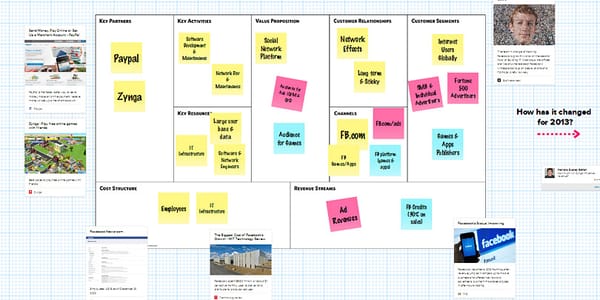Startup Tools: Business Models
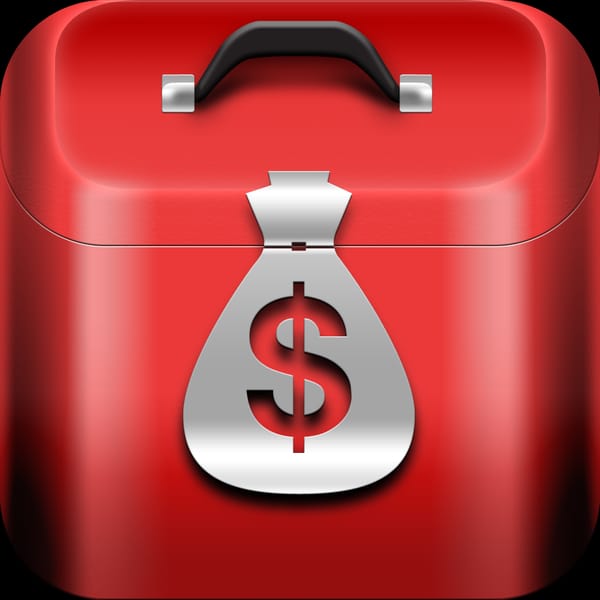
Using the Business Model Generation Tools
There have been some questions posted lately asking for guidance in using the tools associated with the Business Model Generation approach - the Business Model Canvas and the Value Proposition Canvas.
Though the Business Model Canvas was released under Creative Commons and the Value Proposition Canvas under copyright, the requirements for use of the two tools are really quite similar.
Anyone may use the Business Model Canvas and the Value Proposition Canvas for their own work or to support others in understanding, analysing or changing their business models. This includes people who use the tools within their own companies or in a consulting capacity. The requirement, whether Creative Commons or Copyright, is full identification and credit of the source of the tool - Business Model Canvas is BusinessModelGeneration.com and the Value Proposition Canvas is BusinessModelGeneration.com and Business Model Foundry GmbH.
The Business Model Canvas, released under Creative Commons license, is open for building other approaches and variations on the concept. There have been a number of variations discussed and demonstrated here in the Hub and externally. Where variations have been made, recognition of the original source material material must be included on the variation. The text and link BusinessModelGeneration.com should be clearly visible and legible under every canvas.
The Value Proposition Canvas has been released with a slightly more restricted use guideline of Copyright, under which Business Model Foundry has reserved the intellectual property for adaptations and for the inclusion of the canvas in software applications or sold as a tool for others to use (e.g. selling copies of the poster). This can only be done under the express permission and agreement of the Business Model Foundry GmbH.
So, the tools are there for you to use without restriction in modelling your own or other people's businesses. If you wish to include the Business Model Canvas in software solutions, it would be good business practice to first contact the Business Model Generation authors to discuss your intended use. If you wish to use the Value Proposition Canvas in software, in original or adapted form, or sell the canvas as a tool, you must contact the copyright holders, Business Model Foundry, for permission.
What's the Business Model Canvas?
If you're already familiar, you can skip to the next section, ' How do I get started?'.
The Business Model Canvas (BMC) gives you the structure of a business plan without the overhead and the improvisation of a 'back of the napkin' sketch without the fuzziness (and coffee rings).
The Canvas has nine elements: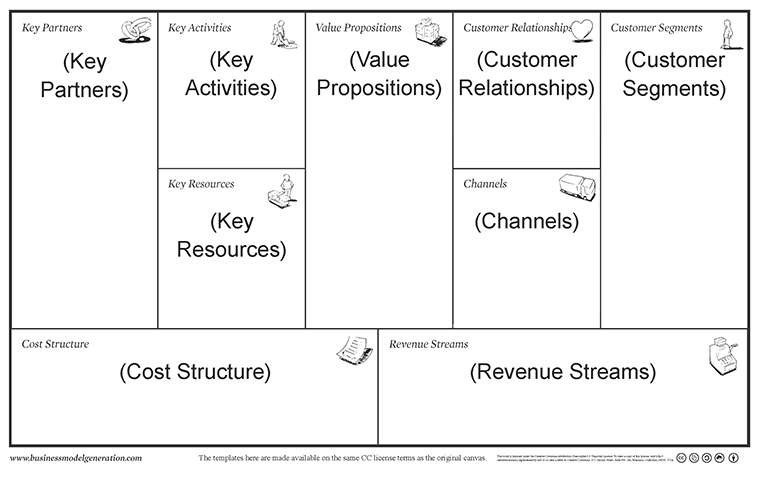
Together these elements provide a pretty coherent view of a business' key drivers-
- Customer Segments: Who are the customers? What do they think? See? Feel? Do?
- Value Propositions: What's compelling about the proposition? Why do customers buy, use?
- Channels: How are these propositions promoted, sold and delivered? Why? Is it working?
- Customer Relationships: How do you interact with the customer through their 'journey'?
- Revenue Streams: How does the business earn revenue from the value propositions?
- Key Activities: What uniquely strategic things does the business do to deliver its proposition?
- Key Resources: What unique strategic assets must the business have to compete?
- Key Partnerships: What can the company not do so it can focus on its Key Activities?
- Cost Structure: What are the business' major cost drivers? How are they linked to revenue?
The Canvas is popular with entrepreneurs and intrapreneurs for business model innovation. Fundamentally, I find it delivers three things:
- Focus: Stripping away the 40+ pages of 'stuff' in a traditional business plan, I've seen users of the BMC improve their clarify and focus on what's driving the business (and what's non-core and getting in the way).
- Flexibility: It's alot easier to tweak the model and try things (from a planning perspective) with something that's sitting on a single page.
- Transparency: Your team will have a much easier time understanding your business model and be much more likely to buy in to your vision when it's laid out on a single page.
How do I get started?
The first time you engage with the canvas, I recommend printing it out or projecting it on a whiteboard and going to town (see below for a PDF). Fill out the elements for your business and then ask yourself 'Does this make sense?' 'What are the most important linkages and components of the model?'
If you're ready to put together something a little more formal (for distribution, presentation, etc.) here's a Google App's template you can copy or download as MSFT PowerPoint:
LINK TO THE DOWNLOADABLE TEMPLATE
If the canvas is working for you, you'll probably end up editing it a lot and presenting it, so there are a few options below for documenting your canvas in an editable format:
Brainstorming alone or in a small group
Documenting the Canvas in Google Doc's or MS Office (PowerPoint)
Documenting a canvas (if you have a Mac & Omnigraffle)
This is a nice tool and very robust.
You can take any of these and project them on to a whiteboard for group sessions
This uses the presentation app in Google Doc's, which does a pretty good job of exporting to PowerPoint.LINK TO INSTRUCTIONS
This one uses layering to manage the canvas LINK TO INSTRUCTIONS
This one needs a little more set up but has lots of features
*Omnigraffle a popular diagramming program for the Mac. It has a fairly easy to use layering environment which you may find handy as you want to tinker with and produce different views of the canvas. You can try Omnigraffle for free (the basic paid version is $99).
What if I want more structure to work through this?
If you'd like a little more structure, the link below will take you to a related curriculum item that has workshop slides, prep. items, and agenda.
LINK TO WORKSHOP PAGEOtherwise, the next sections (10 steps) offer a tutorial on how to use the template. The closing sections describe how to use the Google Doc's/PowerPoint and Omnigraffle templates.
Step 1 (of 10): Customer Segments
 For purposes of using the canvas you should make sure you can answer these questions:
For purposes of using the canvas you should make sure you can answer these questions:
1. Segment Dimensions
Do you have a single or multi-sided market? If you have a multi-sided market you'll have at least as many segments as you have sides. An example of such a market is a media property like CNN.com: they have readers on the one side and advertisers on the other.
2. Segment Composition
If the segment dimensions are the 'macro' analysis of your customer base, then looking within each segment at individual customer types as 'Personas' is the 'micro'. As with economics, this is where most of action happens. You should be able to visualize these Personas- what kind of shoes do they wear? And you should understand what they think, see, feel, and do in your product area. Be sure to list both buyers and users of your product (many Personas will be both). For coaching on this, check out: Tutorial- Personas.
3. Problems, Needs, Habits & Current Alternatives
What job are you doing for the customer? What need are you fulfilling? There are no new behaviors- make sure that you can identify an existing need/problem and identify specific alternatives that your customer uses today. If you're not sure, go out and observe, talk to some representative people. You'll want to be able to clearly link your Value Propositions back to these in the next section.
Output: a list of Personas, organized by Customer Segment if you have more than one segment. I recommend trying to prioritize them- Who would you pitch first if you could only pitch one? Who next? And so forth...
Notes: If you're spending a lot of time on this first item, that's OK (and it's probably good). The Canvas is a tool, not a strategy and not all the nine blocks are equal. The pairing of Customer Segments and Value Propositions is really the 'independent variable' that should be driving everything else in your business model. When I use the Canvas in my Venture Design classes, we usually spend all of the first session (plus time for field research) on Customer Segments and Value Propositions.
Step 2 (of 10): Value Propositions
 Which of the Problems or Needs that you identified in your Personas are you fulfilling? What is unique about your Value Propositions and why does your customer prefer them to their Current Alternatives? You may have a whole lot of these- and that's fine. When you're getting going with this, jot them all done on a whiteboard, index card, Post-It, etc. But then rank them and you'll probably want to winnow out all but the most critical. What things do you do that actually cause a customer to pick you over a competitor or alternative?
Which of the Problems or Needs that you identified in your Personas are you fulfilling? What is unique about your Value Propositions and why does your customer prefer them to their Current Alternatives? You may have a whole lot of these- and that's fine. When you're getting going with this, jot them all done on a whiteboard, index card, Post-It, etc. But then rank them and you'll probably want to winnow out all but the most critical. What things do you do that actually cause a customer to pick you over a competitor or alternative?
For example, at Leonid, an enterprise software company I founded, we thought our largest customers worked with us because of the cost savings we offered and our knowledge about best practices. It turned out that was mostly wrong- reducing their time and risk to get new services to market was the most important. It's not that the other things weren't important, but they weren't the top Value Proposition. That made a difference on how we sold the product and how we focused on operationalizing it for customers.
Once you've isolated these, try mapping them to the Customer Segments; it will look something like this:
LINK TO THE DOWNLOADABLE TEMPLATE
This mapping says 'We have 3 personas. Persona 1 cares about VP 1 & 2. Persona 2 cares about VP 2; Persona 3 cares about VP3. (One segment only so segments not noted)'.
Output: a prioritized list of Value Propositions and linkages from each Personas to the VP's relevant to them.
Notes: Again, this pairing is the key driver for most business models and if you want more on how to describe and discovery what to put in this part of the canvas, I recommend this: Tutorial- Personas.
Maybe you feel like you're in good shape on understanding the customer's world but you don't have any validation on whether the Value Propositions are clicking because this is a new venture? If you're not sure, that's OK and good for you for acknowledging the uncertainty! It's the responsible thing to do. The key is to write down those assumptions, prioritize them, and figure out the quickest and cheapest way to prove or disprove them. That's what Lean/Startup is about and there are resources here to help you with that, if you'd like- Tutorial: Lean Startup.
Step 3 (of 10): Channels
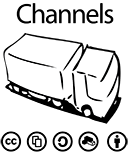
Channels includes entities you use to communicate your proposition to your segments, as well as entities through which you sell product and later service customers (see AIDAOR journey below). For example, if you sell bulbs for light houses and there's a website all light house attendants purchase equipment, that site is a sales Channel. If you use Google AdWords, that's a Channel, too (for getting attention). If you use a third party company to service the bulbs when they break, that's also a Channel.
Output: a list of important Channels, linked to Personas or Segments if they differ substantially. Make notes on what steps are relevant for each- promotion, sales, service, etc. See Note this section for more structure on this.
Notes: Channels and the next item, Customer Relationships, define your interface with the Customer. It's important to think all the way through the customer 'journey' in specific terms. For most businesses, the way they get a customer's attention is different than the way they onboard them or support them over the long term. For this, I recommend the AIDA.OR framework (attention-interest-desire-action-onboarding-retention) and storyboarding your way through it. Here's a post explaining all that- Storyboarding AIDA(OR). If you don't want to do the storyboards, I recommend at least making notes about your customer journey through the AIDA(OR) steps.
Another consideration is whether your channels will give you enough visibility into the user, including, for example, a way to follow up with users. Not sure? Document your assumptions Lean Startup style and figure out how you'll quickly prove or disprove them.
Step 4 (of 10): Customer Relationships
 How does the customer interact with you through the sales and product lifecycle? Do they have a dedicated personal contact they see? Call? Is all the interaction over the web? Do they never see you at all but instead talk to a Channel? A few litmus test questions you may want to ask yourself at this point:
How does the customer interact with you through the sales and product lifecycle? Do they have a dedicated personal contact they see? Call? Is all the interaction over the web? Do they never see you at all but instead talk to a Channel? A few litmus test questions you may want to ask yourself at this point:
- Can the Value Proposition be delivered to the Customer this way? All the way through from promotion, to sale, to post-sale service? (See AIDAOR above on this.)
- Can you make the numbers work?
- Is there a premium support product you need to create/test? Many companies, like Apple, have rejected the false choice of 'Do we provide phone support or not?' instead offering personal support for a reasonable charge.
Output: a description of Customer Relationships, with notes if they differ across Customers (between Segments or among Personas within a Segment) or across the customer journey.
Notes: If you're a startup, be sure to document and review critical assumptions here. Also, the focal items are in a kind of specific order- you should validate your Segments and their relationship to the Propositions above all else. If this means you provide personal support in the early days (a 'concierge test' in Lean Startup terms) to do discovery and validation of Segments and Propositions, that's OK. You can subsequently test the Customer Relationship models. (Here's a post on using consulting as a concierge vehicle in B2B if you want more detail: Consulting as B2B Concierge Vehicle).
Step 5 (of 10): Revenue Streams
 I won't bore you with proclamations about the importance of revenue- you get it. If you have an existing business, this will be self-evident.
I won't bore you with proclamations about the importance of revenue- you get it. If you have an existing business, this will be self-evident.
At this point, you should map Segments to Propositions to Revenue Streams. The example below says 'Revenue stream 1 is driven by Persona 1′s involvement with Propositions 1 & 2; Revenue Stream 2 is driven by Persona 2′s involvement with Proposition 2; and Revenue Stream 3 with Persona 3′s involvement with Proposition 3.' That's relatively diverse- yours may be much simpler and that's fine.
Output: a list of Revenue Streams, linked (mutually) to Personas (or Segments if the mappings are the same within a set of Personas) and Value Propositions
Notes: If you have a startup or are re-engineering the business, this is a time to look at where you're driving revenue and whether it aligns with the rest of your focal points. Are you charging on value? Perceived value? They say everyone loves their banker; hates their lawyer. Why is that? Is there an actionable analog in your business?
Congratulations on making it halfway! At this point, you may want to step back and look at the picture you've created about your Offering and Customers. The next four steps deal with your 'Infrastructure', the plumbing you need to execute:Step 6 (of 10): Key Activities
 These are the crucial things the business needs to do to deliver on its propositions and make the rest of the business work- for example, if selling through 3 rd parties is part of the model, then activity around channel management is probably pretty important.
These are the crucial things the business needs to do to deliver on its propositions and make the rest of the business work- for example, if selling through 3 rd parties is part of the model, then activity around channel management is probably pretty important.
For a product-driven business, this probably includes ongoing learning about users and new techniques to build better product. If you're focused on doing a bunch of things for a particular set of customers (ex: comprehensive IT for law offices), this probably includes maintaining superior expertise on the segment(s) and creating or acquiring products and services that are a good fit, whatever that entails. For an infrastructure business (ex: electric utility), it probably includes keeping the infrastructure working reliably and making it more efficient.
You'll then want to consider how the Key Activities (and/or Key Resources) drive your Value Propositions:
Outputs: a list of Key Activities linked to your business' Value Propositions.
Notes: One question this analysis should raise for you is whether or not certain Activities and Resources are actually core, actually focal to your business, something you'll want to think through .
Step 7 (of 10): Key Resources
 Key resources are the strategic assets you need in place, and you need in place to a greater or more targeted degree than your competitors. The Business Model Canvas proposes that there are three core business types: product, scope, and infrastructure. These tend to have similar types of Key Resources.
Key resources are the strategic assets you need in place, and you need in place to a greater or more targeted degree than your competitors. The Business Model Canvas proposes that there are three core business types: product, scope, and infrastructure. These tend to have similar types of Key Resources.
The following diagram describes how Key Activities drive the accrual of Key Resources:
Outputs: a list of Key Resources linked to your business' Key Activities.
Notes: Product-driven businesses have a differentiated product of some sort. Rovio, the company that makes the popular app Angry Birds, is such a company. Key Resources in product-driven businesses are typically key talent in critical areas of expertise and accumulated intellectual property related to their offering.
Scope-driven businesses create some synergy around a particular Customer Segment. For example, if you started a business that would take care of all the IT needs for law firms, that would be a scope-driven business. These businesses typically have key knowledge about their segment, a repeatable set of processes, and sometimes infrastructure, like service centers.
Infrastructure-driven businesses achieve economies of scale in a specific, highly repeatable area. Telecommunications is traditionally an infrastructure business. Retailers focused on retail, like Walgreens or Costco, are primarily infrastructure-driven businesses. The Key Resources for this type of business are, you guessed it, various types of physical or virtual infrastructure.
Let's take a single product category: diapers. The Honest Company or another innovating around compostable or otherwise more environmentally friendly diapers would be a product-driven take on the category. Procter & Gamble which has a cradle-to-grave strategy for providing consumer products is a scope-based take; so are various baby-focused retailers. Kimberly-Clark (wood pulp) or DuPont (chemicals and polymers) are both infrastructure-based takes: diapers is just another way to sell something they produce at scale with relatively little differentiation.
Step 8 (of 10): Key Partnerships
 At this point, hopefully the Canvas has helped you sharpen and articulate your business' focal points. What Activities and Resources are important but not aligned with what's uniquely strategy for you? What's outside of your business type? Could partners do some of those? Why? Which?
At this point, hopefully the Canvas has helped you sharpen and articulate your business' focal points. What Activities and Resources are important but not aligned with what's uniquely strategy for you? What's outside of your business type? Could partners do some of those? Why? Which?
I recommend mapping Key Partners to Key Activities. If an activity is key, it's still part of your business model. This is a way to denote which specific Partners are handling various Key Activities for you.
Output: a list of Key Partnerships with notes on their relationship to Key Activities.
Step 9 (of 10): Cost Structure
 You've worked to understand how your Key Activities drive your propositions and hence your revenue. How do they drive costs? Are those costs well aligned with the key Value Propositions? Are the costs more fixed or variable as you test different business models? Are they more linear with your scaling or more fixed? You'll want to have these in mind as you tweak your model.
You've worked to understand how your Key Activities drive your propositions and hence your revenue. How do they drive costs? Are those costs well aligned with the key Value Propositions? Are the costs more fixed or variable as you test different business models? Are they more linear with your scaling or more fixed? You'll want to have these in mind as you tweak your model.
For purposes of linking things together, I'd look at how your Key Activities drive your Cost Structure:
If there are major cost components that don't map to a Key Activity, I'd take a closer look at those costs.
Congratulations- you have a working canvas! The section below offers a few analytical ideas and suggestions for next steps.Output: a list of Cost Structure elements with notes on their relationship to Key Activities.
Step 10 (of 10): Applications, Analysis & Next Steps
Core Applications
The most core and obvious applications of the Canvas are to ask:
- Does it make sense?
- Could it be better?
- Does the rest of my team understand and agree? Have additional ideas?
- (rinse and repeat at least quarterly)
Competitiveness
The canvas does a good job of helping you figure out your business, which is a good place to start. You also want to look at the competitive environment and think about if and how you have/maintain a long term competitive advantage.
For this, I like Michael Porter's Five Forces framework ( Wikipedia Page; see also Chapter 2 of ' Starting a Tech Business '). Try walking through the Five Forces for your company and then bounce back to your canvas. How does it all hang together?
Next Steps
Every business is a work in progress (sorry, I try to avoid saying things like that but it seemed to fit here). As you go through the canvas, you may encounter areas that give you trouble. The table below summarizes a few of the most common that I see in my work as a mentor and coach:
You're having trouble crystallizing your Customer Segments and Value Propositions
I recommend the material here on Personas. See also Chapters 1-3 of ' Starting a Tech Business '. This will help you create a deep, actionable understanding of your customers.
You're looking for a more end-to-end view of how to design the venture- customer discovery, Lean-style experimentation, product design, product development.
The Venture Design materials provide a more comprehensive view of how to approach a new product or venture.
You're looking for a systematic way to organize your work on the venture over a period of weeks.
Startup Sprints is a popular program for stepping through a new product and/or venture. It's organized around agile-style iterations which you can size according to your pace.
You're not sure how much product to build (vs. license, leverage, etc.) or how to put it together.
See Chapter 4 of 'Starting a Tech Business'. This will help you think about what you need to build from a functional perspective so you can look at the available technology objectively and make strategic design decisions.
You're not sure where and how to partner.
See Chapter 8 of 'Starting a Tech Business'. This will give you a framework to use in partnership evaluations and a supplemental example.
Using the Google Doc's/PowerPoint Template
If you're not familiar with it, Google Doc's is a web-based office suite, similar to MS Office. If you have a gmail account, you can access it (no guarantees- that was the case last time I checked).
First, you'll want to link to the template file: BUSINESS MODEL CANVAS TEMPLATE IN GOOGLE DOC'S.
Once you're accessed the file, you can make make it your own by going to the File menu and either 'Make a copy...', creating a copy in your own Google App's domain or you can use the 'Download as...' option to download it as PowerPoint (and a few other formats).
Probably the most key thing here is that I set it up so you edit the list of Canvas items (Segments, Relationships, etc.) in the Slide Master. I know what you're thinking- I hate those Master things and I never use them. Generally, neither do I. But in this case it's a good way to achieve some rudimentary layering, allowing you to do show things on top of the Canvas without having to recopy all the elements. You'll see what I mean on the file. The key thing is that to edit the list of Canvas items: Go to the 'View' menu, then go to 'Master' and edit the first slide you see under the Layout label over on the left: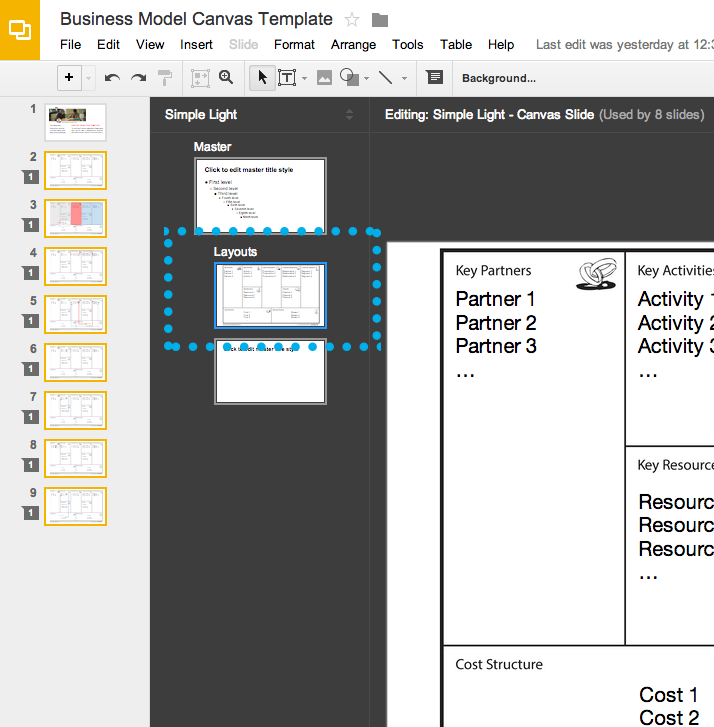
Last note: The lines with multiple bends that you see are called a 'Polyline' in Google Doc's. If you click the downward arrow on the line item in the menu bar, you'll see it.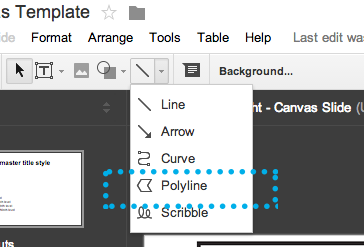
Using the Omnigraffle Template
Omnigraffle: Initial Editing of the 9 Key Elements in the Canvas
The first thing you'll want to do is fill out the elements of the canvas. These layers are set to be visible and editable in the Omnigraffle template you just downloaded. Click and edit: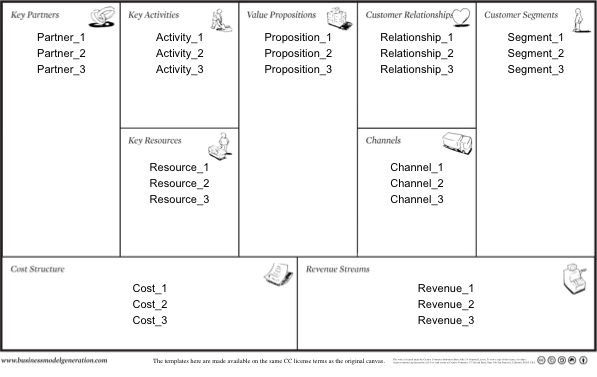
Omnigraffle: Creating the Triparte View
One popular view of the canvas is in the three parts shown below- a) the offering b) customers and c) infrastructure.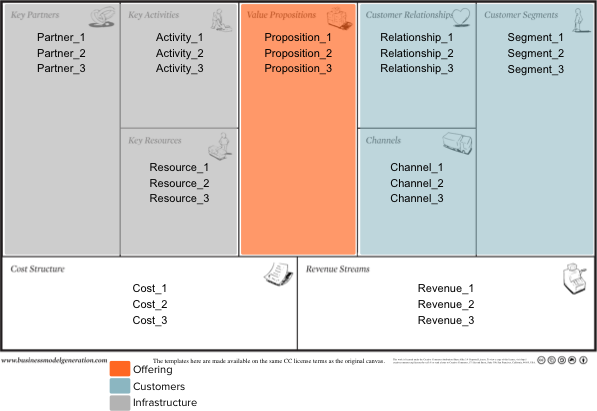
To get this view, we need to show a layer that's hidden by default. I'll be drip feeding basic, related Omnigraffle instructions as we go through this. If you prefer a more comprehensive introduction, they have a pretty good set of intro videos.
You can see the layers as small rectangles under the page ('canvas') we're on: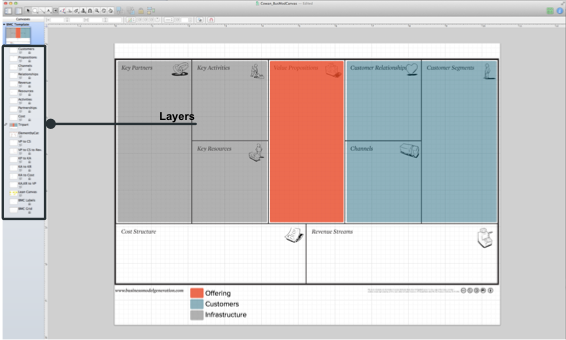

You'll notice on each that when you hover over it there are three icons: an eye, a printer, and a padlock. The eye controls whether or not the layer is shown- try clicking it on and off to see. The printer controls whether the layer gets printed. The padlock controls whether or not the layer is editable. This is will be important as we go on- in general I think you'll find things a lot easier if you lock all the layers you're not editing. To show the background above, click on the show/eye property of the layer labeled 'Tripart'.
Notice also the pencil- that tells you the layer you're editing- DON'T FORGET TO CHECK THIS AS YOU GO ALONG, ESPECIALLY IF YOU'RE NEW TO WORKING WITH LAYERS.
If you've updated the canvas elements with the items you want (for the moment at least) then I would lock (using the padlock icon) all those layers. If you don't, you may find you're having background/foreground problems in selecting the shape you want on the layers that follow.
Omnigraffle: Creating the Items by Business Type View
This next layer allows you to color code the various elements against a legend (which you can create at the bottom of the diagram). One likely use for this is when you feel the elements of your model bleeds into several core 'business types' and you want to delineate that. (In his book 'Business Model Generation', Alex Osterwalder put forward to the idea of three core business types: 'product innovation', 'customer relationship management', and 'infrastructure'). You may want to categorize various parts of the business for any number of reasons- things you do now vs. things you propose to do, etc.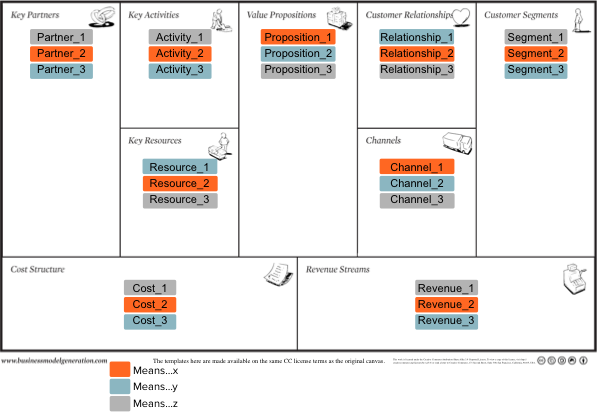
Before you move on to this view, you'll want to hide and lock (if you unlocked it) the 'Tripart' layer we just covered (that's the padlock icon within the layer sub-menu- see directly above). Then just click 'show layer' (the eye has it) on the layer 'ElementbyCat'. Congratulations, you're on to your second layer. One thing I like to do periodically to make sure that I'm getting things on the layer I want is to toggle 'show' (eye) on the layers to make sure things are where I think. Another note on layers: If you goof up (I do a lot), moving things from one layer to another is easy but a little (to me) non-obvious. What you need to do is copy or cut whatever it is you want to move and then before you paste, make sure the layer you want the content to land on is the one under edit (that it has the pencil showing) which you can do by click to the left of the layer.
Omnigraffle: Creating the Value Proposition to Customer Segment Mapping
This view is a simple mapping that says 'These various propositions link to these various customer segments.'.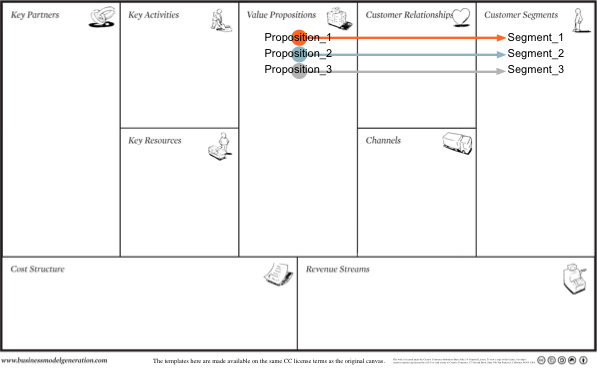
You'll notice I've hid all the element layers except for Propositions and Segments. That's my personal preference- most of the diagrams that follow are about focus and clarity.
You'll need to use shapes, lines and (possibly magnets) to manipulate this diagram substantially. It's not a big deal, trust me. The colored shapes are a circle with a line attached to it. You can see the inspector below: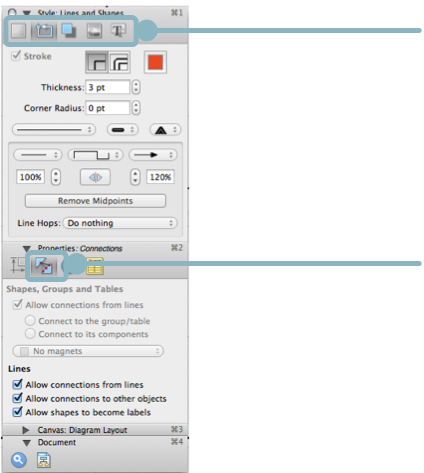
This is where you go to set the properties of most items on Omnigraffle. The top section has a series of buttons you select between to manipulate fill, lines, shapes, shadows (if you roll that way), images, and text. The bottom section has a few items but the only item I've every found myself using the is the properties for 'magnets'- see below. (For more in the Inspector, see the OmniGraffle Tutorial). If, for example, you want to change the color of one of these lines, you'll need to use the Inspector to update the fill color of the circle and the line color of the line. So, you'd use the fill style for the circle and the line style for the line.
Magnets are attachment points on shapes- pretty much everything in the application has them. They can make the lines a little hard to go where you want- you may find they keep being drawn to a place you don't want them to go. If this is the case, you may want to select the line and go to the magnet properties (see above) and uncheck the item that says 'Allow connections to other objects'. This will keep the line for anchoring to other objects which is what you want if it keeps veering off to a place you don't like. If you want to see the Magnets, go to the top menu: View >> Magnets.
Another note on Lines: if you're having trouble bending them to the places you want, experiment with right clicking on them and adding or removing 'midpoints', which are basically arms/points of freedom in the lines.
Yet another notes on lines and the circles: If you have multiple propositions mapping to the same customer segment, you mind find the visual explanation clearer if you make all the lines the same color. You can see this done in a few of the items below and decide for yourself.
You'll find several other layers in the template corresponding to the items below. All the tips and tricks you need to work with them are described in the above examples. Other layers:
Value Proposition to Customer Segment to Revenue Mapping
Key Partner to Key Activity Mapping
Key Activity to Key Resource Mapping
Key Activity to Cost Mapping
Key Activity and/or Key Resource to Value Proposition Mapping
Omnigraffle: Lean Startup- Assumptions and Experiments Mapping
This one's of a slightly different ilk- a 'lean canvas', if you will. The idea here is to map the key assumptions attached to the various parts of your business model and pair those assumptions quick and inexpensive experiments which will allow you to quickly validate or invalidate the assumptions. This is the central idea of the 'Lean Movement'. If you'd like a quick backgrounder on that you can check out the Speaking section of the site- see the item 'Planning'.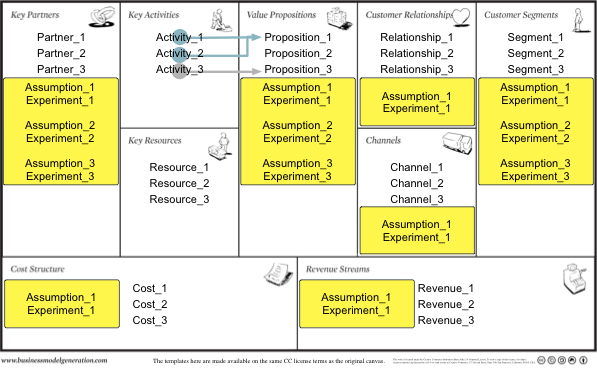
These items are rectangles with text on the inside. I think it's helpful to see the elements with the assumptions and experiments next to them if you can make all that fit. If you can't just hide the various element layers (Customers, Propositions, etc.) and overlay the assumptions rectangle on them.
If you're more clever than me with Omnigraffle (I know there are quite a lot of you out there!) or just more clear in general, please post your comments here.
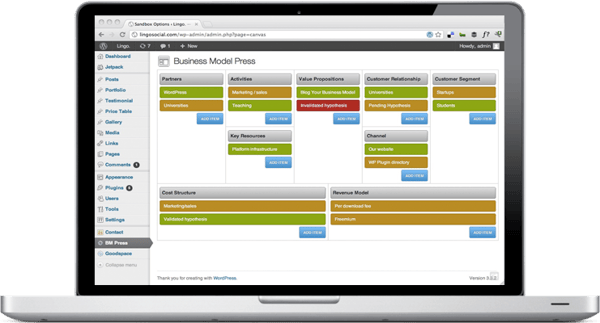
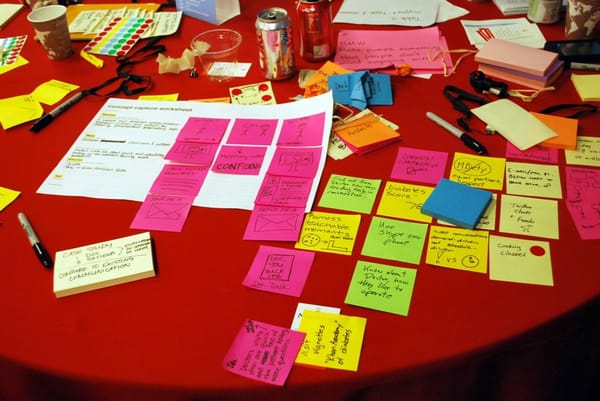
Using The Platform for Evidence-Based Entrepreneurship™
Evidence-Based Entrepreneurship™ changes the way we invest in startups, teach entrepreneurship, run startups, and think about commercializing innovation. Read more...
Live: 1,411 teams have already tested 36,605 hypotheses and conducted 32,647 customer interviews leading to 7,416 pivots
9 in 10 New Ventures Fail
It is time to change the way we manage our portfolio of startups.
As an Investor
Steve Blank (architect of the Lean LaunchPad process) explains how LaunchPad Central gives investors X-Ray vision into their investments.
As a Practitioner
Jim Hornthal shares how LaunchPad Central helps the teaching and mentoring of student teams as a practitioner of the Lean LaunchPad at Stanford, Berkeley & Princeton
See how customers are leveraging LaunchPad Central
As far as university classes go, NUvention pretty much tops them all. Setting undergraduate and graduate students alike loose to form their own teams, NUvention allows students to build their own startups by following the extremely experiential Lean LaunchPad methodology, and pitch to some of the country's great entrepreneurial minds. They are pioneers in the space by embedding their entrepreneurship program university-wide.
"Reviewing LaunchPad Central is 100x better for me as a faculty member than reading business plans..."
- Mike Marasco, Director of Farley Center of Entrepreneurship and Innovation
Victory Spark is a mentor-driven seed accelerator, part of the Global Accelerator Network, exclusively for America's U.S. Military Veterans. Veteran-initiated startups are exposed to a national group of mentors and investors who believe that veterans can be leaders on a new front line - entrepreneurship. They have led the way through their early adoption of the Lean LaunchPad methodology.
"As a mentor, it allows me to step into the incubator/accelerator without ever having to be there."
- Ross Bjella, Mentor at VETransfer
